
Quick Guide: How To Use BPASS
This page includes steps to complete the critical tasks within BPASS. If you are having difficulty completing any tasks including ones that are not featured below please get in touch via apiary.sites@dpi.nsw.gov.au. Videos are also being created for key BPASS functions. You can view them in BPASS playlist of the TOCAL Youtube channel.
Download the BPASS QuickGuide - How to use BPASS (PDF, 5720.95 KB)
Logging into BPASS
BPASS shares a login system with DPIRD Biosecurity and Food Safety’s apiary registration system (BYTE). This means apiarists can use the same login and password to manage their beekeeping registration as well as their beekeeping licenses and permits. It also allows DPIRD to automatically verify registration details when apiarists apply for and renew their sites (speeding up processing and saving applicants from having to send in paperwork).
Getting access to BPASS – First Time Only
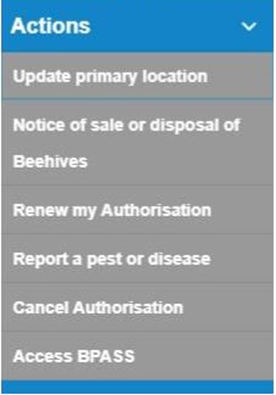 Once you have signed up to BYTE successfully, follow these simple steps:
Once you have signed up to BYTE successfully, follow these simple steps:
To simplify access for you, BPASS will use the same email address and password as the BYTE (BFS) Portal where you manage your Beekeeper Registration information. DPIRD Biosecurity & Food Safety have sent details to all registered beekeepers about how to signup for the BYTE Portal.
Step 1: Go to bfs.dpi.nsw.gov.au on your computer, tablet or smart phone.
Step 2: Enter the email address and password you have set up for the BYTE (BFS) Portal where you manage your beekeeper registration information.
Step 3: Once the main screen is displayed, navigate to My authorisation on the left hand menu. You should see a link on the right hand side of the screen “Access BPASS”.
Step 4: The first time you use this you will be asked to consent to DPIRD Biosecurity & Food Safety providing your contact and registration details to the BPASS system. After reading this, click “agree” and your account will be set up in BPASS.
Step 5: From 25 August, Once connected as above you can access BPASS via bpass.dpi.nsw.gov.au
Getting access to BPASS – After Setup
Once you have set up BPASS access in Byte you can access Byte directly by going to bpass.dpi.nsw.gov.au
Use the email address and password you set up for the BYTE (BFS) Portal to log in.
Forgotten your BPASS password?
On the login page, click on the yellow “Forgot Password?” link and enter your email address. A link will be sent to your email address with instructions on how to reset.
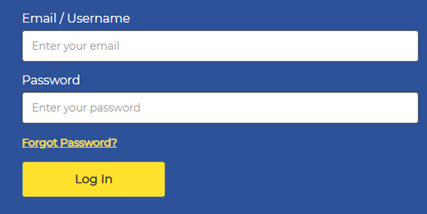
Viewing your existing Sites, Permits and Licenses
First log into BPASS.
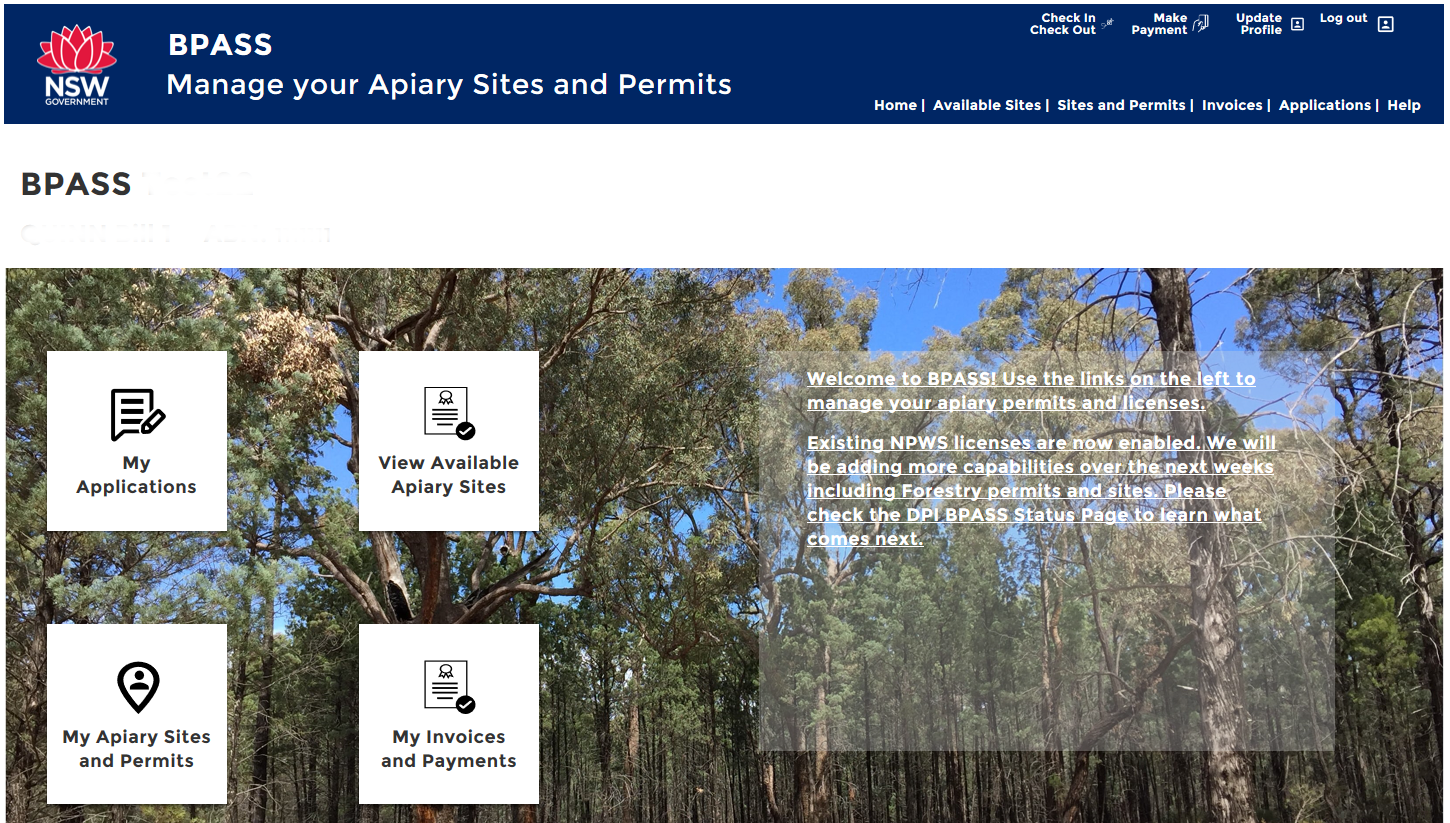
On the BPASS homepage, click or tap on the box titled: “My Apiary Sites and Permits” or click on “Sites and Permits” at the top right of any page in BPASS.
The page will display a list of current and former sites that you hold permits or licenses for.
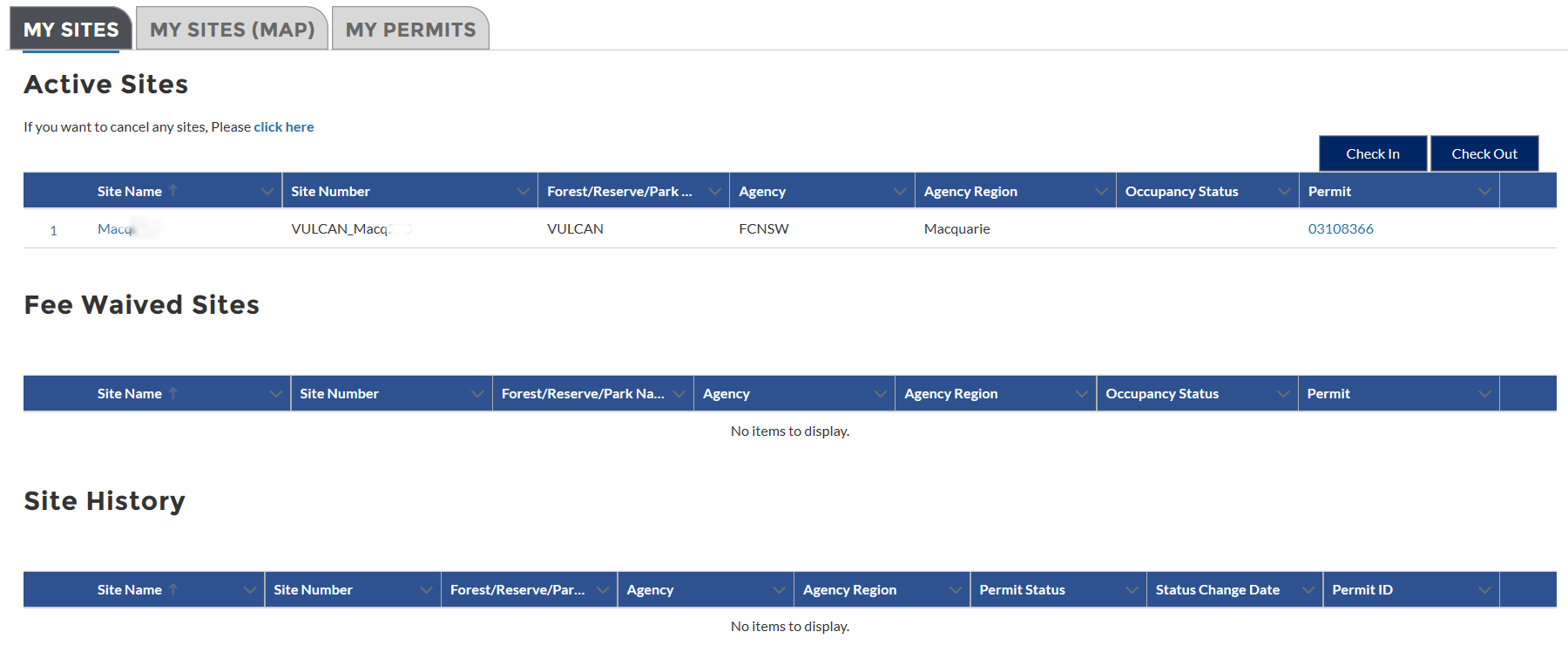
“Active Sites” lists are all sites which you hold a current permit or license for and are being charged the standard apiary site fee for.
“Fee Waived Sites” lists are all sites which you hold a current permit or license for and a fee waiver has been applied to (Drought Waiver etc.).
“Site History” lists sites you previously held a permit or license for within BPASS but have since been cancelled or withdrawn. Note that BPASS does not store historical information from prior to September 2020.
Click on the site name to view more information about each site,
The “My Sites (MAP)” tab allows you to view your sites on a map along with other vacant and occupied sites in the area.
If you would like to apply you see vacant, click on “Available Sites” at the top of the page and follow the site application process from there.
“My Permits” lists all your current and former permits and licenses. A separate permit will be issued for each permit or license issuer and for each permit expiry date. (e.g. all NPWS licenses expiring in Dec 2021 will be grouped together in one permit, but Forestry permits expiring in Dec 2021 will be in a separate permit.)
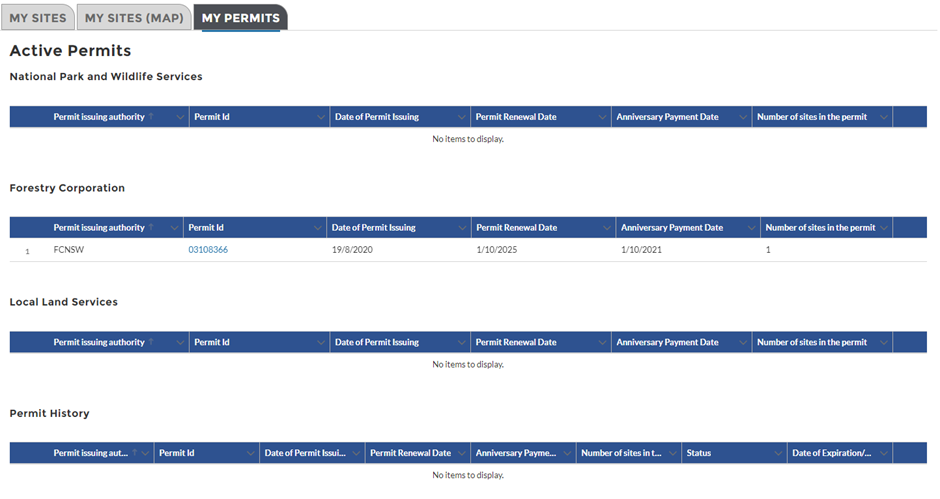
Click on the Permit Id to view further information about your permit. To see a list of sites under that permit, click on the “Sites” tab.

To view a copy of your Permit or License Document, click on “Permit Document”. A separate permit document will be issued for each permit or license issuer and for each permit expiry date. (e.g. all NPWS licenses expiring in Dec 2021 will be grouped together.). The permit document lists all the sites currently included in the permit.
What if one of my sites is not listed?
- Check the BPASS status on the DPIRD website to confirm which land managers have already migrated to BPASS. Not all land managers will have their data in the system from the start.
- Check whether you have multiple logins to the BYTE / BFS system. You may need to login with another account.
- Send an email to the apiary sites helpdesk at apiary.sites@dpi.nsw.gov.au; providing your name and company name, the permit numbers and details of the sites you are missing.
“Check-in”: Notifying land managers when you move your hives
Informing the land managers when you place beehives on a site or when you remove them helps operational staff know when your hives are present and can help ensure you are notified if a planned or unplanned event affects sites in your area. It is also a requirement of your license or permit. BPASS make this process very easy.
“Check In” – notifying that you have placed your hives on a site
After logging into BPASS click on the “CheckIn CheckOut” icon at the top right hand side of the page.
From the My Sites list, Click on the “Check In” button at the top-right of the sites list.
The page will display a list of all the sites which you have not already marked as having sites on:

Use the tickboxes in the left column to select the sites you want to “Check In”, tick the box to the left of: “Do you wish to check in the selected site? “ and click on “Check In”.
The list of active sites will be updated with a honeybee indicating sites you have checked in.

“Check Out” – notifying that you have removed your hives from a site.
Follow the same procedure as Check In, but select “Check Out”
Finding Available Sites
After logging into BPASS, click on the “View Available Apiary Sites” icon on your home page or the “Available Sites” link at the top right hand side of the BPASS page.
The map will initially display all apiary sites in the system including sites which currently have permits. Watch a video the highlights some of the more advanced BPASS map features on the TOCAL Youtube channel: https://youtu.be/38nHXPeS6X8.
The Filter options on the left hand column allow you to filter what sites are displayed on the map. If you select “Show Vacant Sites Only”, only sites which are currently available to apply for will be displayed.
The “Search on Map” box allows you to enter a search term including site number, location etc. As you type matching suggestions will be displayed. Click on the suggestion to view the matching site on the map.
Available sites are marked in the following way:
Available Forestry Corporation of NSW Apiary Ranges are displayed as a purple area with cross-hatches from top left to bottom right. Exclusion areas within the ranges where hives cannot be placed have a mustard coloured background. Unavailable apiary ranges are displayed in a grey color with cross hatches from bottom left to top right.
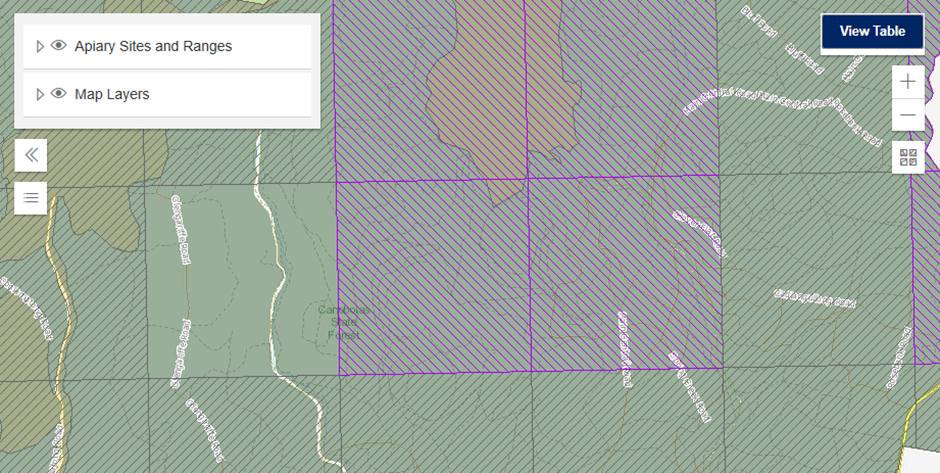
Available sites on NSW National Parks and Wildlife Services parks and reserves are indicated by a purple honeybee icon. Occupied sites are indicated with a grey hive icon.
![]()
Click on the available range or site to display information about the site including site name, allocation type: Long Term Vacant (LTV) site or Expression of Interest (EOI), Forest or Reserve name and the number of holds or applications already received for the site.
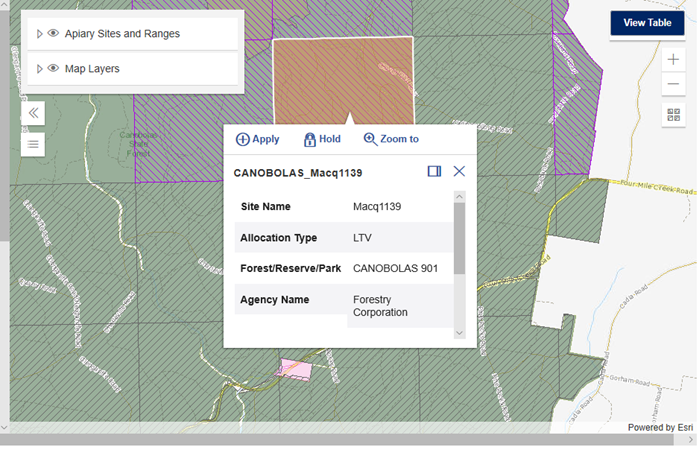
If the site is an LTV site you can choose to request a hold or apply for the site. Click on “Apply” or “Hold”. The site you have selected will be added to a list on the left hand side of the screen (scroll down if you can’t see it initially). You can continue to look for other available sites on the map or proceed to submit your hold request or application for the site. You can watch a video that demonstrates how to hold or apply for sites on the BPASS How To playlist of TOCAL's Youtube page.
Submitting an application for a site
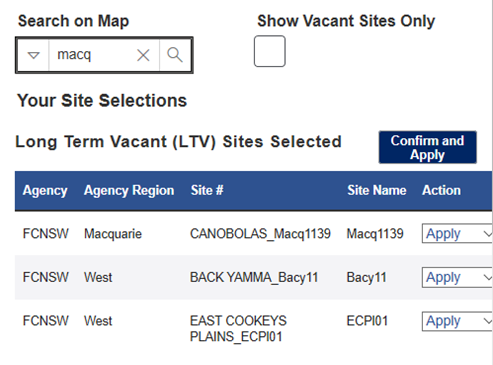
Once you have selected your sites they will appear in a list beneath the filters and search box on the left hand side of the page. Check the list and use the Action dropdown to “Remove” any that you no longer wish to apply for.
Click “Confirm and Apply” to start your application
Long Term Vacant (LTV) Site Application
For a Long-Term-Vacant Site first confirm your Personal Details. Most of the details will already be completed from your Beekeeping Registration information in the BFS / BYTE portal. If any of these details are incorrect you will need to go the BYTE portal to update before restarting your application. Use the “Next” button to progress to your registration details.
If your company has more than one beekeeping registration you will need to pick which registration you want to associate with your application. Review and agree to the Apiary Terms and Conditions, and Insurance Declaration and then submit. A confirmation will be displayed on the screen.
The land holder will review your application in BPASS to check for any issues with the sites or your application. If approved you will be issued an invoice for the sites. Once paid you will receive permit documents.
Expressions of Interest (EOI) Application
EOI allocations are used for new beekeeping sites identified by agencies and existing sites which have had a permit in the last 2 years. An EOI process is used to ensure a broad range of beekeepers have the opportunity to apply.
Follow the same process to select your EOI site and start your application. In addition to the personal and registration details required for an LTV application you will need to provide an assessment of your capabilities.
Please answer all questions. If you reply yes to compliance with the Honeybee Code of Practice or the Pest and Disease question you must upload a PDF scan or high quality photograph. Click on the icon to upload a file or drag a drop a file onto the “Or drop files” words.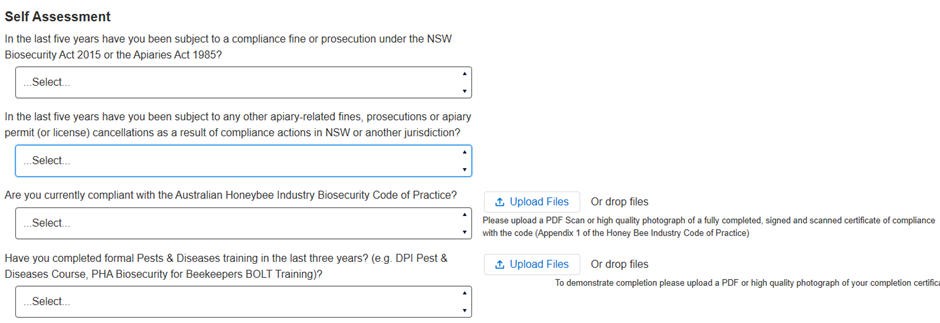
Read the declaration and privacy statement and hit “Submit”.
Your application will be assessed after the closing date of the EOI. You will receive an email notification of the outcome. If you have been successful you will receive an invoice for the new site(s).
Checking the location of your sites
As a permit holder it’s your responsibility to ensure that their hives are placed in the correct location. Placing hives in a location that is not in a designated setdown location or within an apiary range boundary may contravene the terms and conditions of your permit and could result in fines or cancellation of your permit.
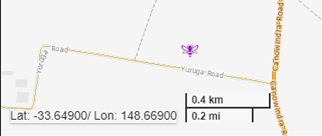 BPASS’s available sites and “My Sites” maps now provide two ways to help you determine the location of your setdown sites, boundary or other features.
BPASS’s available sites and “My Sites” maps now provide two ways to help you determine the location of your setdown sites, boundary or other features.
- A scale is now displayed at the bottom left of the map. As you zoom in or out of the map this will adjust. You can use this to estimate the distance between features on the map. Together with your vehicle odometer this can help identify how long along a road a site is for example
- A GPS pinpointing feature that allows you to click on any point on the map and the digital Latitude and Longitude are displayed at the bottom left of the map for that point. This can help you in a number of ways e.g.:
- To identify where your setdown site is currently designated: At home on your PC click on your setdown site within the BPASS My Sites map. Take a note of the Lat and Long displayed. Enter this into a GPS device as a Waypoint, or enter the coordinates into your smartphone mapping app (e.g. Google Maps). Go onsite and compare the location of the setdown in BPASS with the actual site.
- To help identify the boundary of an apiary range (Forestry Corporation sites only): At home on your PC view the apiary range on the BPASS My Sites map. Click on a location where a road or other map feature intersects with the apiary range boundary. Take note of the coordinates displayed. Repeat this at other points around the boundary. Enter the locations into a GPS device as Waypoints, or enter the coordinates into your smartphone mapping app (e.g. Google Maps). Go onsite and compare the location of the setdown in BPASS with the actual site.
If the location you are using or propose to use does not match the one recorded in BPASS, take a GPS reading of the location and send it with details of the site to apiary.sites@dpi.nsw.gov.au. The proposed location will be notified to your respective land manager who will review and confirm if the new location is approved. You can only use a setdown location that has been approved by the land manager.
Submitting a Waiver Request
During a period when waivers can be requested a notification will appear on the home page of BPASS and a link will be displayed on the “My Sites” page:

Click on the link to start the waiver request process.
The screen will present a list of sites which have not already had a waiver applied or requested and are currently eligible for you to request a waiver review.
Select the sites which have been impacted by fire and you wish to apply a waiver for:
- Use the tick box on the left side of each row to select sites you wish to apply for.
- Click on “Request Waiver” to progress to the next stage.

The next page will display the sites you have selected and allow you to enter the reason for your request. Here you must enter the reasons for your request for each site.
First select the reason for the waiver request and then enter the details for each site.
- For damaged infrastructure: You will need to describe what the damage is, the roads normally used to access the site and you must upload maps or sketches showing the route normally taken.
- For damage to the tree canopy, a description of the damage to the trees and upload recent photos of the trees in the vicinity of the site.
Use the “Upload Files” function to include the supporting documents.
- Tip: If the text box appears too small, you can drag the bottom corner to make it easier to see more text as you enter it.

If you do not wish to progress with a site you selected in the previous page, just hit “Back” to return the list and update your selection of sites.
If you do not have sufficient information, click on “Save”. You can follow the original links to return to this page and the information entered will be retained.
Once you have entered details for all of the sites you wish to request a review for hit Submit. A success message will be displayed.
Your request will be submitted to the respective land manager responsible for each site. They will review each request. They may approve, decline or may request further information from you in support of your request. The timing of this will depend on the information you provide as well as the number of requests being received from other apiarists.
Once a decision has been made for each site requested on a permit you will be notified. If a waiver has been granted your invoice will be adjusted and a refund provided.
You can check on the status of each waiver request by visiting the “My Applications” section of BPASS and selecting the “Waiver Requests” tab.

Annual Site Review and Payment
If your permit has more than one year of validity left you will get the opportunity to review the sites before paying you annual permit fee. You will receive a notification 2 Months before the anniversary date of the permit (ie. Generally at the start of August for Forestry Corporation Sites, at the start of November for NPWS sites and at the start of May for LLS sites).
You then have 1 month to review your sites and use the “Cancel” function to cancel any sites or permits that you no longer need.
1 month before the anniversary date an invoice will be generated for any sites on your permit that you have not cancelled. See below for instructions on how to pay an invoice.
If your permit is expiring at the anniversary date you will need to follow the instructions below to apply for an renewal of the permit.
Paying an Invoice
After logging in to BPASS, click on “Invoices” to see a list of your current and past invoices. Click on “Pay Invoices” to see a list of your invoices that are due for payment. Use the tabs (|FNCSW, NPWS, LLS) to view invoices from each issuing agency.
Use the tick box on the left to select which invoices to pay and click “Make Payment”. (You can only pay invoices for one agency at a time)
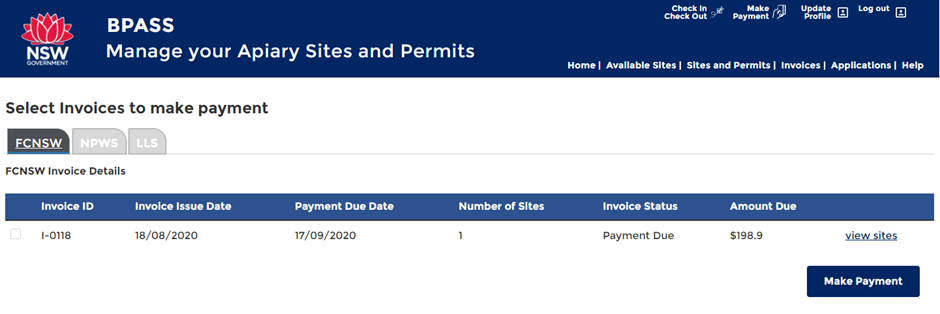
A box will appear warning you that you are going to the Service NSW payment screen. Click “Continue”.
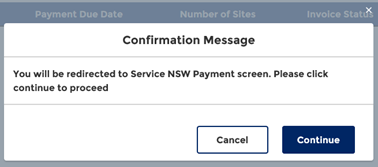
Note: You must have popups enabled to view the Service NSW page.
You will be taken to the Service NSW payment page which offers 3 options to pay your invoice:
- Credit Card (all popular cars supported)
- Pay ID (the new type of bank transfer)
- Or BPAY
Click on the option you prefer. Charges for Credit Card and Pay ID will be listed. BPAY is free of charge but can take up to 3 days to process.
You can make a credit card payment directly by entering your credit card details and selecting Pay Now. For Pay ID and BPAY the page will display the details for you to enter into your own bank’s internet banking service. Once payment has been successfully paid you will be redirected to BPASS where you can view your sites and permit information.
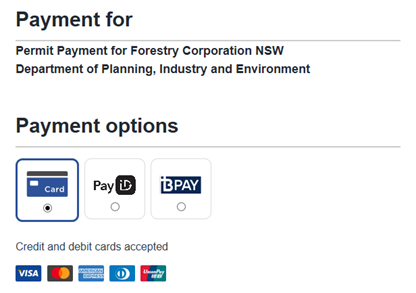
Pop-up Blockers preventing you making payments in BPASS
Payments for invoices in BPASS are made via Service NSW’s payment system. This system is hosted on Service NSW’s website. When you click on the link within BPASS to make a payment some browsers may automatically block the Service NSW website as a general measure to stop links from opening other websites without your permission.
If you are experiencing issues when you click on the link within BPASS to make payment, follow the instructions from your browser provider to allow popups for the Service NSW website at: https://pay.service.nsw.gov.au/
The following are links to articles from the main browser providers:
- Chrome: https://support.google.com/chrome/answer/95472?hl=en&co=GENIE.Platform%3DDesktop
- Safari: https://support.apple.com/en-hk/guide/safari/sfri40696/mac#:~:text=Allow%20or%20block%20pop%2Dups%20on%20all%20websites,the%20bottom%20of%20the%20list.
- Firefox: https://support.mozilla.org/en-US/kb/pop-blocker-settings-exceptions-troubleshooting
- Microsoft Edge: https://support.microsoft.com/en-us/search?query=allow%20pop%20ups%20in%20edge
Renewing a Permit
NSW Apiary Policy supports the issuing of 5 year apiary permits (or licenses) with the option for further renewal subject to the apiarist meeting criteria for usage and biosecurity. Existing permits migrated into BPASS may have shorter terms and require renewal according to each landholder’s permit schedule.
If you have received a notice that your permit or license is due for renewal you must log in to BPASS and confirm you wish to renew your permit or license.
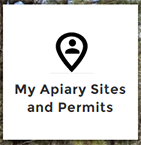 Steps to apply for a permit renewal:
Steps to apply for a permit renewal:
- Log into BPASS (see above for steps).
- Click on the “My Apiary Sites and Permits” box. A list of your current sites will be displayed.
- Click on the “My Permits” tab. A list of your active and cancelled permits will be displayed.
- Review the “Permit Renewal Date” for the listed permits.
- If a renewal is due in the next 2 months, click on the Permit Id.
- Details of your permit will be displayed.
- If you do not wish to continue with the permit, click on “Cancel Permit” and follow the steps to confirm cancellation.
- Use the “Sites” tab to review the sites included on the permit. If you wish to cancel some (but not all) of the sites on the permit, follow the instructions below to cancel sites before you renew the permit.
- Click on the “Renew Permit” button on the right.
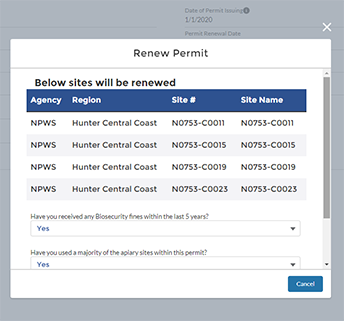
- A list of sites eligible for renewal on the permit will be displayed and you will be prompted to answer two questions to determine eligibility for renewal:
- Have you received any Biosecurity fines within the last 5 years?
- Have you used a majority of the apiary sites within this permit? (If the Summer 2019/20 fires affected your access and usage of sites you can still select “Yes” for 2020 renewals.
- Scroll down and click on the “Confirm Renewal” button.
- You permit renewal application will be reviewed by DPI and the respective land manager. If approved an invoice will be issued for the permit.
- Once the invoice has been paid (or a waiver automatically applied if eligible) a new permit document will be issued.


Cancelling a permit
To cancel all of the sites on a permit:
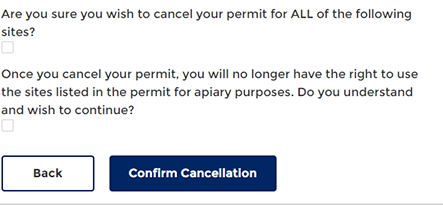
- Log into BPASS (see above) and click on the “My Apiary Sites and Permits” icon.
- Find the permit you wish to cancel on the list of sites.
- Click on the Permit number to display the details of the permit.
- Click on the “Cancel Permit” icon at the top right of the page.
- Review the list of sites to be cancelled.
- If you wish to go ahead, tick the two boxes and click on “Confirm Cancellation” (this cannot be undone!)
Cancelling a site
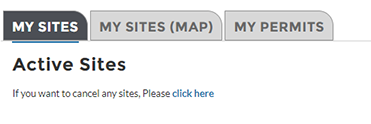 To cancel a single site without affecting the other sites on as permit:
To cancel a single site without affecting the other sites on as permit:
- Log into BPASS (see above) and click on the “My Apiary Sites and Permits” icon.
- Below the Active Sites heading it says “If you want to cancel any sites, Please click here.”. Click on “click here”.
- A list of sites available to cancel will be displayed.
- Click to tick the box to the left of the sites you wish to cancel and twice more to confirm you wish to cancel.
- Click on the “Cancel Sites” button to confirm cancellation (this cannot be undone).

